Kenwood DMX8020DABS, DMX7520DABS User Manual
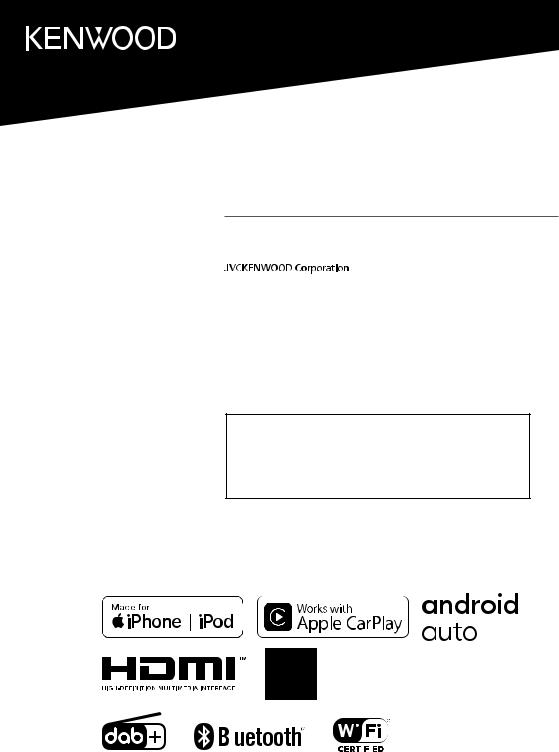
MONITOR WITH RECEIVER
DMX8020DABS
DMX7520DABS
INSTRUCTION MANUAL
•Updated information (the latest Instruction Manual, system updates, new functions, etc.) is available from
<https://www.kenwood.com/cs/ce/>.
•The Instruction manual is subject to change for modification of specifications and so forth. Be sure to download the latest edition of the Instruction manual for reference. <http://manual.kenwood.com/edition/im404/>
The product with the Hi-Res Audio logo is conformed to Hi-Res Audio standard defined by Japan Audio Society.
The logo is used under license from Japan
Audio Society.
|
|
|
|
|
|
|
|
|
|
|
|
© 2020 JVCKENWOOD Corporation |
|
|
|
IM404_ref_E_En_00 (E) |
|
|
|
|
|||

Important Notice on Software
ÑÑSoftware License on This
Product
The software embedded in this product comprises a number of independent software components, each of which is copyrighted by JVCKENWOOD Corporation or by a third party.
This product uses software components that are based on an End-User License Agreement (hereinafter called “EULA”) stipulated by JVCKENWOOD Corporation and by third parties.
The EULA dictates the availability of the source codes of free-software components as a prerequisite to distributing them in executable form under the terms of the GNU General Public License or the Lesser General Public License (hereinafter called “GPL/LGPL”). To get information about the software components that are subject to the terms of the GPL/LGPL, please visit the following Website:
Website URL https://www2.jvckenwood.com/gpl/
Queries concerning the contents of the source code or the like will not be accepted.
Please note that software components based on a EULA that is not subject to the terms of the GPL/LGPL or those that have been developed or created by JVCKENWOOD Corporation will be excluded from the scope of source code disclosure.
Because licenses to use software components distributed under the GPL/LGPL are offered to the customers for free of charge, no warranty is granted to the customers, whether explicitly or implicitly, to the extent of the applicable laws.
Unless otherwise stipulated by the applicable laws or agreed upon in writing, the copyright holders or those who are entitled to modify and redistribute the software components are not held responsible for any and all damages resulting from their use or from inability to use them. For more information about the terms of use of the software components, required items of compliance and so on, please refer to the GPL/LGPL.
Customers wishing themselves to use a software component that is subject to the GPL/LGPL embedded in this product are encouraged to read the terms of the corresponding license before use. Because each individual license
is prescribed by a third party other than
2
JVCKENWOOD Corporation, the original (English) of the license is presented.
EULA
ÑÑSoftware License Agreement
JVCKENWOOD Corporation (hereinafter called “Licensor”) holds either the copyright to the embedded software or the right to sublicense it. This agreement establishes the conditions under which the customer uses this “Licensed Software.”
The customer shall agree to the terms of this license agreement before proceeding to use Licensed Software.
This agreement is deemed to have taken effect when the customer (hereinafter called “User”) has used a product implementation of Licensed Software.
The Licensed Software may contain software Licensor has been licensed to use by third parties directly or indirectly. Some third parties may have terms of use prescribed for their customers, apart from this Software License Agreement. This agreement does not apply to such software. Be sure to consult “Important Notice on Software” as presented separately.
Article 1 (General)
Licensor grants to User a non-exclusive, non-assignable right of use Licensed Software within the country where the User purchases the Product (hereinafter the "Country") (except for the exception provided for in Paragraph 1, Article 3).
Article 2 (Right of Use)
1.The rise of use granted under this agreement is the right to use Licensed Software in this product.
2.User may not duplicate, copy, modify, add to, translate or otherwise alter, or loan licensed Software and the associated literature in whole or in part.
3.Use of Licensed Software is limited to a private extent , and Licensed Software may not be distributed, licensed or sublicensed for any purposes whatsoever, including commercial use.
4.User shall use Licensed Software as per the instruction manual or instructions given in the help file and may not use or duplicate data in violations of the regulations of the Copyright Law or other governing laws by using Licensed Software in whole or in part.

Article 3 (Terms of License)
1.In assigning this product, User may not retain the original copy of the embedded Licensed Software (including associated literature, updates and upgrades) and any duplicates and associated literature with regard to
the license to use Licensed Software. User may transfer Licensed Software only to the condition of binding the assignee to abide by the terms of this Software License Agreement.
2.User may not reverse-engineer, disassemble, decompile or otherwise analyze the source code of Licensed Software.
Article 4 (Rights to Licensed Software)
All rights to Licensed Software and the associated literature, including copyrights, shall reside with Licensor or
the original right holder who has granted the Right of Use and right to sublicense to Licensor (hereinafter referred to as “Original Right Holder”), and User does not have any rights other than Right of Use granted hereunder with regard to Licensed Software and the associated literature.
Article 5 (Exemption Granted to Licensor)
1.Licensor and Original Right Holder do not assume any responsibility for damages caused to User or third parties resulting from the exercise by User of the license granted hereunder, unless otherwise provided by any law to the contrary.
2.Licensor does not warrant Licensed Software to be merchantable, compatible and fit for specific purposes.
Article 6 (Responsibility for Third Parties)
If disputes over the infringement of third parties’ intellectual property rights, such as copyrights and patent rights, arise out of the use of Licensed Software by User, User shall resolve these disputes at User’s own expenses while keep Licensor and Original Right Holder harmless.
Article 7 (Secrecy Obligation)
User shall keep confidential Licensed Software provided hereunder, information contained in the associated literature or the like and those provisions of this agreement not yet in public knowledge and may not disclose or leak these to third parties without prior written consent from Licensor.
Article 8 (Cancellation of the Agreement)
Licensor reserves the right to cancel this agreement forthwith and claim compensation from User for the damages caused by such cancellation when User:
(1)Breaches any of the provisions of this agreement, or
(2)Has received a petition for seizure, provisional seizure, provisional disposition or any other kind of compulsory execution.
Article 9 (Destruction of Licensed Software)
If this agreement is terminated under the provision of the foregoing paragraph, User shall destroy Licensed Software, along with all associated literature and its duplicates, within two (2) weeks from the date of termination.
Article 10 (Copyright Protection)
1.Copyrights and all other intellectual property rights relating to Licensed Software shall reside with Licensor and Original Right Holder and in no circumstances with User.
2.User shall abide by the laws relating to copyrights and intellectual property rights in using Licensed Software.
Article 11 (Export Control)
1.Licensed Software and the associated literature or the like may not be exported to places outside the Country (including transmission outside the Country over the Internet or the like).
2.User agrees that Licensed Software is subject to export controls imposed by the Country and the United States of America.
3.User agrees to comply with all the international and domestic laws that apply to this software (U.S. Export Administration Regulations and regulations established by the U.S., the Country and their governmental agencies regarding usage by end users and export destinations).
Article 12 (Miscellaneous)
1.Even if this agreement is invalidated in part by law, all other provisions shall remain in effect.
2.Licensor and User shall consult each other in good faith to resolve any matters not provided for in this agreement or questions arising from the interpretation of this agreement.
3.Licensor and User agree that this agreement is governed by the law of Japan and that all disputes involving claims and obligations that may arise out of this agreement will be settled
by arbitration at the Tokyo District Court as the |
|
court of first instance. |
3 |
|

 Contents
Contents
Before Use |
6 |
|
iPod/iPhone |
32 |
Precautions.................................................................... |
6 |
Preparation.................................................................. |
32 |
|
How to read this manual.......................................... |
6 |
iPod/iPhone Basic Operation................................ |
33 |
|
|
|
Search Operation...................................................... |
34 |
|
Basic Operations |
7 |
Functions of the Buttons on the Front Panel.... 7 |
|
Turning on the Unit.................................................... |
8 |
Initial Settings.............................................................. |
8 |
Adjusting the volume.............................................. |
10 |
Viewing Angle............................................................ |
11 |
Touch screen operations........................................ |
11 |
HOME screen descriptions..................................... |
12 |
Popup menu............................................................... |
12 |
Source selection screen description.................. |
13 |
Source control screen descriptions.................... |
15 |
List screen.................................................................... |
16 |
Widget |
17 |
Widget........................................................................... |
17 |
Multi Widget............................................................... |
17 |
Photo Frame Widget................................................ |
19 |
Widget SETUP............................................................. |
19 |
APPS |
21 |
Wireless Mirroring Operation............................... |
21 |
USB Mirroring Operation........................................ |
21 |
Apple CarPlay Operation........................................ |
23 |
Android Auto™ Operation...................................... |
26 |
USB |
29 |
Connecting a USB device....................................... |
29 |
USB Basic Operation................................................ |
29 |
Search Operation...................................................... |
31 |
Radio |
35 |
Radio Basic Operation............................................. |
35 |
Memory Operation................................................... |
36 |
Selecting Operation................................................. |
37 |
Traffic Information.................................................... |
37 |
Radio SETUP................................................................ |
38 |
Digital Radio |
39 |
Digital Radio Basic Operation............................... |
39 |
Storing Service in Preset Memory....................... |
40 |
Selecting Operation................................................. |
40 |
Traffic Information.................................................... |
41 |
Digital Radio SETUP................................................. |
42 |
Bluetooth Control |
43 |
Information for using Bluetooth® devices....... |
43 |
Register the Bluetooth device.............................. |
44 |
Bluetooth Setup........................................................ |
45 |
Playing the Bluetooth Audio Device.................. |
47 |
Using the Hands-Free Unit.................................... |
49 |
Hands-Free Setup..................................................... |
53 |
Other External Components |
55 |
View Camera............................................................... |
55 |
Use Dashboard Camera.......................................... |
57 |
External audio/video players (AV-IN)................. |
58 |
HDMI source............................................................... |
58 |
TV tuner........................................................................ |
58 |
4

Setup |
59 |
Monitor Screen Setup............................................. |
59 |
System Setup.............................................................. |
59 |
User Interface Setup................................................ |
59 |
Special Setup.............................................................. |
61 |
Display Setup.............................................................. |
61 |
AV Setup....................................................................... |
63 |
Controlling Audio |
65 |
3-way speaker system setup................................. |
65 |
Speaker / X’over setup............................................. |
66 |
Controlling General Audio..................................... |
68 |
Equalizer Control....................................................... |
68 |
Volume Offset............................................................. |
69 |
Zone Control............................................................... |
70 |
Sound Effect................................................................ |
71 |
Listening Position / DTA.......................................... |
72 |
Audio Setup memory.............................................. |
73 |
Remote control |
74 |
Battery Installation................................................... |
74 |
Functions of the Remote control Buttons........ |
74 |
Connection/Installation |
77 |
Before Installation..................................................... |
77 |
Installing the unit...................................................... |
78 |
Troubleshooting |
87 |
Problems and Solutions.......................................... |
87 |
Error Messages........................................................... |
88 |
Appendix |
89 |
Playable Media and Files........................................ |
89 |
Specifications............................................................. |
90 |
About this Unit........................................................... |
93 |
English 5

Before Use
 Before Use
Before Use
Precautions
#WARNINGS
ÑÑTo prevent injury or fire, take the following precautions:
•To prevent a short circuit, never put or leave any metallic objects (such as coins or metallic tools) inside the unit.
•Do not watch or fix your eyes on the unit’s display when you are driving for any extended period.
•If you experience problems during installation, consult your KENWOOD dealer.
ÑÑPrecautions on using this unit
•When you purchase optional accessories, check with your KENWOOD dealer to make sure that they work with your model and in your area.
•You can select a language to display menus, audio file tags, etc. See User Interface Setup (P.59).
•The Radio Data System or Radio Broadcast Data System feature won’t work in areas where the service is not supported by any broadcasting station.
ÑÑProtecting the monitor
•To protect the monitor from damage, do not operate the monitor using a ball point pen or similar tool with a sharp tip.
ÑÑCleaning the unit
•If the faceplate of this unit is stained, wipe it with a dry soft cloth such as a silicon cloth. If the faceplate is stained badly, wipe it with a cloth moistened with neutral cleaner, then wipe it again with a clean soft dry cloth.
NOTE
•Applying spray cleaner directly to the unit may damage its mechanical parts. Wiping the faceplate with a hard cloth or using a volatile
liquid such as thinner or alcohol may scratch the surface or erase the screened print.
ÑÑAcquiring GPS signal
The first time you turn on this unit, you must wait while the system acquires satellite signals for the first time. This process could take up to several minutes. Make sure your vehicle
is outdoors in an open area away from tall buildings and trees for fastest acquisition.
After the system acquires satellites for the first time, it will acquire satellites quickly each time thereafter.
ÑÑAbout GLONASS
This unit uses Global Navigation Satellite System (GLONASS) in addition to GPS.
Combining GPS and GLONASS can refine positioning accuracy than using GPS only.
ÑÑCaution for Smartphone Users
Simultaneously running multiple applications on your smartphone while screen sharing places heavy demand on the microprocessor of the phone, potentially affecting communication and performance.
For best results while pairing with your Kenwood receiver, please be sure to close any unused applications.
How to read this manual
•The screens and panels shown in this manual are examples used to provide a clear explanation of operations.
For this reason, they may be different from the actual screens or panels, or some display
patterns may be different from the actual ones.
•Display language: English is used for the purpose of explanation. You can select a display language from the [SETUP] menu. See
User Interface Setup (P.59).
6

Basic Operations
 Basic Operations
Basic Operations
Functions of the Buttons on the Front Panel
1 |
2 |
3 |
4 |
5 |
6 |
7 |
NOTE
•The panels shown in this manual are examples used to provide a clear explanation of operations. For this reason, they may be different from the actual panels.
Number |
Name |
Motion |
||
|
|
|
Remote |
• Receives the remote control signal. |
1 |
|
|||
|
|
|
Sensor |
|
|
|
|
S, R |
• Adjusts the volume. |
|
2 |
|
||
|
|
|
(Volume) |
The volume will go up to 15 when you keep pressing R. (P.10) |
|
|
|
ATT |
• Switches attenuation of the volume on/off. |
|
3 |
|
||
|
|
|
|
|
|
|
|
HOME |
• Displays the HOME screen (P.12). |
|
4 |
|
||
|
|
|
|
• Pressing for 1 second turns the power off. |
|
|
|
|
• When the power is off, turns the power on. |
|
|
|
MENU |
• Displays the popup menu screen. |
|
5 |
|
||
|
|
|
|
• Pressing and holding turns the screen off. |
|
|
|
|
• Displays the APP (Apple CarPlay/Android Auto/Wireless Mirroring) screen. |
|
6 |
|
|
|
|
|
|
|
• Pressing and holding displays the Voice Recognition screen (P.51). |
|
|
|
|
• When neither Apple CarPlay, Android Auto, nor a Bluetooth Hands-Free phone is |
|
|
|
|
connected, pressing and holding displays Bluetooth pairing waiting dialog. (P.44) |
|
|
|
CAM |
• Switches view camera display on/off. (P.55) |
|
7 |
|
||
|
|
|
|
The camera whose view is displayed first changes according to the "Camera |
|
|
|
|
Setup" setting and the shift lever position in the shift gate. The camera whose view |
|
|
|
|
was displayed last is kept and the same camera view will be displayed the next |
|
|
|
|
time. If its assignment setting is changed, the rear camera view is displayed. |
English 7
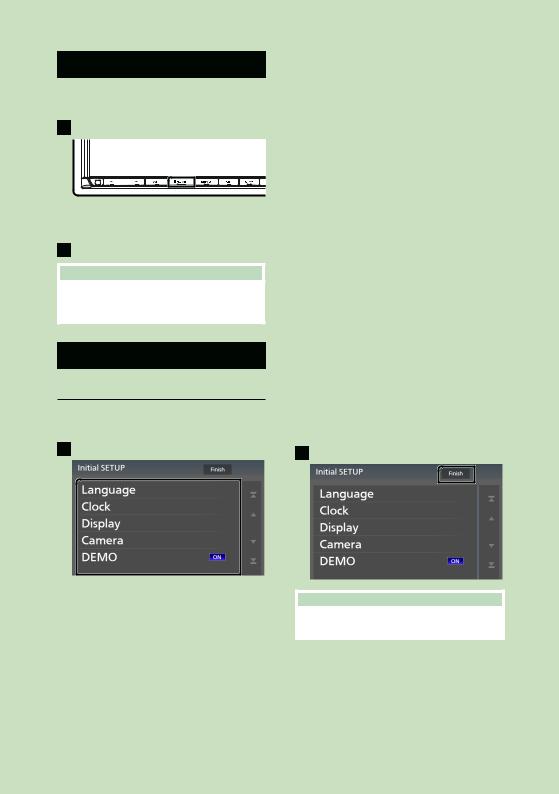
Basic Operations
Turning on the Unit
The method of turning on is different depending on the model.
1 Press the [HOME] button.
hTheunit is turned on.
●●To turn off the unit:
1 Press the [HOME] button for 1 second.
NOTE
•If it is your first time to turn the unit on after installation, it will be necessary to perform Initial SETUP (P.8).
Initial Settings
Initial SETUP
Perform this setup when you use this unit first time.
1 Set each item as follows.
■■[Language]
Select the language used for the control screen and setting items. Default is "British English(en)”.
1Touch [Language].
2Touch [Language Select].
3Select the desired language.
4Touch [ ].
].
For details, see User Interface Setup (P.59).
■ [Clock]
Sets the synchronization of the clock and adjusts it.
For detailed operation, see Calendar/clock settings (P.10).
■■[Display]
Set the key illumination color.
If it is hard to see the image on the screen even, adjust the viewing angle.
1Touch [Display].
2Touch [Key Colour].
3Select the desired color.
4Touch [ ].
].
5Touch [Viewing Angle].
6Select a viewing angle.
7Touch [ ].
].
For details, see Viewing Angle (P.11).
For details, see Display Setup (P.61).
■■[Camera]
Set the parameters for the camera.
1Touch [Camera].
2Set each item and touch [ ]. For details, see Camera Setup (P.55).
]. For details, see Camera Setup (P.55).
■■[DEMO]
Set the demonstration mode. Default is “ON”.
2 Touch [Finish].
NOTE
•These settings can be made from the SETUP menu. See Setup (P.59).
8
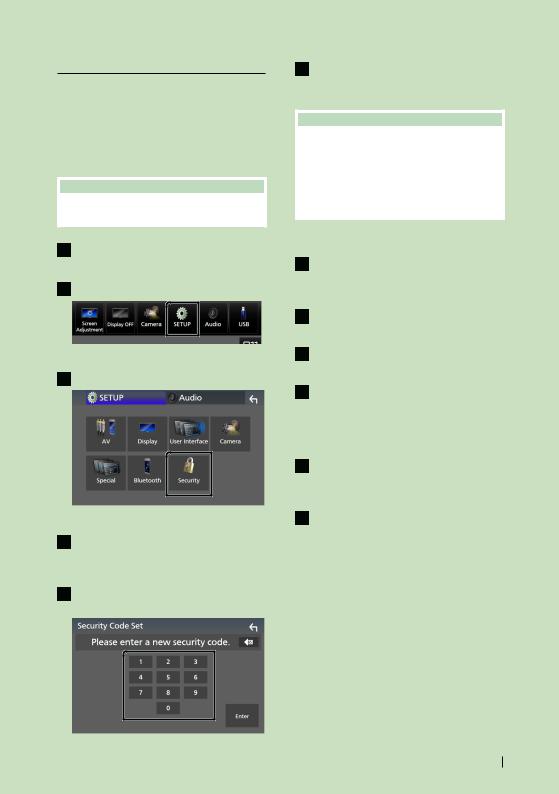
Security Code Setup
You can set up a security code to protect your receiver system against theft.
When the Security Code function is activated, the code cannot be changed and the function cannot be released. Note the Security Code can be set as the 4 to 8 digit number of your choice.
Preparation
• Set [DEMO] to [OFF] in the Special screen
(P.61).
1 Press the [MENU] button. hhPopup menu appears.
2 Touch [SETUP].
hhSETUP Menu screen appears.
3 Touch [Security].
hhSecurity screen appears.
4Touch [Security Code Set] on the Security screen.
hhSecurity Code Set screen appears.
5Enter a security code with 4 to 8 digit number and touch [Enter].
Basic Operations
6Enter the same code again and touch
[Enter].
Now, your security code is registered.
NOTE
•Touch [BS] to delete the last entry.
•If you enter a different security code, the screen returns to step 5 (for the first code entry).
•If you have disconnected the Receiver from battery, enter the correct security code as that you have entered in step 5 and touch [Enter]. You can use your receiver.
To change the security code:
1Touch [Security Code Change] on the
Security screen.
hhSecurity Code Set screen appears.
2Enter the current registered security code and touch [Enter].
3Enter a new security code with 4 to 8 digit number and touch [Enter].
4Enter the same code again and touch
[Enter].
The new security code is registered.
To clear the security code:
1Touch [Security Code Cancellation] on the Security screen.
hhSecurity Code Set screen appears.
2Enter the current registered security code and touch [Enter].
The security code is cleared.
English 9

Basic Operations
Calendar/clock settings
1Press the [MENU] button. hhPopup menu appears.
2Touch [SETUP].
hhSETUP Menu screen appears.
3 Touch [User Interface].
hhUser Interface screen appears.
4 Set each item as follows.
Scroll the page to show hidden items.
■■[Time Format]
Select the time display format.
[12-Hour]/[24-Hour] (Default)
■■[Clock]
[GPS-SYNC] (Default): Synchronizes the clock time with the GPS.
[Manual]: Set the clock manually.
■■[Time Zone]
Select the time zone.
■■[Clock Adjust]
If you select [Manual] for Clock, adjust the date and time manually. (P.60)
NOTE
•Please set the date and time. If they are not set, some functions may not work.
Adjusting the volume
You can adjust the volume (0 to 40).
Press [R] to increase, and press [S] to decrease.
Holding [R] increases the volume continuously to level 15.
10

Viewing Angle
You can adjust the viewing angle when the image on the screen is difficult to see evenly. The smaller the (negative) value, the more whitish the image on the screen looks.
1Press the [MENU] button. hhPopup menu appears.
2Touch [SETUP].
3Touch [Display].
hhDisplay screen appears.
4Touch [Viewing Angle].
5Select an angle you want to set up.
Default is "0". (P.61)
Basic Operations
Touch screen operations
To perform operations on the screen, you need to touch, touch and hold, flick or swipe to select an item, display a setting menu screen or change pages.
●●Touch
Touch the screen gently to select an item on the screen.
●●Touch and hold
Touch the screen and keep your finger in place until the display changes or a message is displayed.
●●Flick
Slide your finger quickly to the left or right on the screen to change the page.
You can scroll a list screen by flicking up/down on the screen.
●●Swipe
Slide your finger up or down on the screen to scroll the screen.
English 11

Basic Operations
HOME screen descriptions
Most functions can be performed from the HOME screen.
1
2 
3
1• Widget (P.17)
––You can change the widget by flicking left or right on the widget area.
––Touch the widget to display the detailed screen.
2• Displays the source selection screen. (P.13)
3• Short-cut playback source icons (P.14)
Display the HOME screen
1 Press the [HOME] button.
hhHOME screen appears.
Popup menu
1Press the [MENU] button. hhPopup menu appears.
2Touch to display the popup menu.
1
The contents of the menu are as follows.
•Displays the Screen Adjustment screen.
(P.59)
• Turns the display off. (P.13)
•Displays the view camera screen.
(P.55)
•Displays the SETUP Menu screen.
(P.59)
• Displays the Audio screen. (P.65)
•Displays the control screen of current source. Icon feature differs depending on the source. This icon is for USB source.
• Close the popup menu.
•Displays the Android Auto device list. This icon appears only when Android Auto is connected and two or more devices can be used as Android Auto source.
1• Short-cut source icons: The source changes to the one you have set with a short-cut. For the short-cut setting, refer to Customize Short-cut source icons on HOME screen (P.14).
12
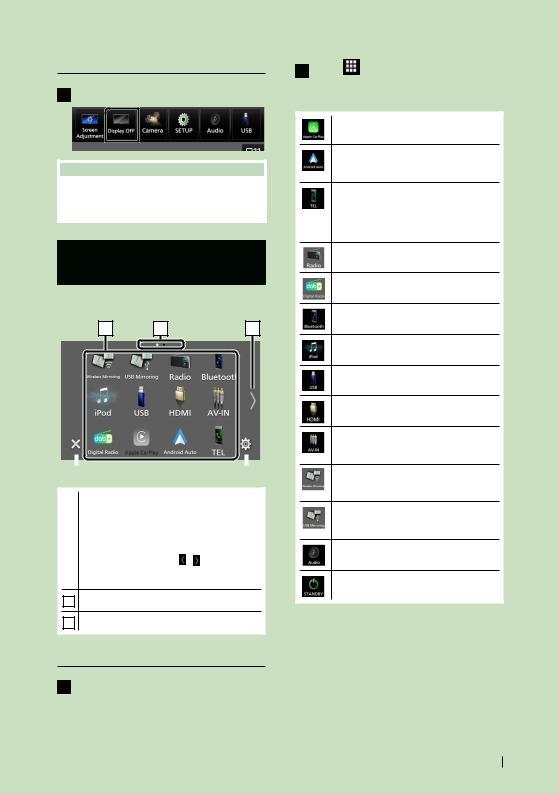
Turn off the screen
1 Select [Display OFF] on the popup menu.
NOTE
•Touch the display to turn on the screen.
•To display the clock while the screen is off, it is necessary to set "OSD Clock" to "ON". (P.61)
Source selection screen description
You can display icons of all playback sources and options on the source selection screen.
1 |
2 |
3 |
|
|
|
|
|
|
|
|
|
|
4 |
|
5 |
|
||
|
|
|
• Changes playback sources. |
||||
1 |
|
||||||
|
|
|
|
For playback sources, see Select the |
|||
|
|
|
|
playback source (P.13). |
|||
|
|
|
• Page indication |
||||
|
2 |
|
|||||
|
|
|
|
|
|
|
|
|
|
|
• Changes pages. (Touch [ ]/[ ].) |
||||
|
3 |
|
|||||
|
|
|
|
You can also change pages by flicking left or |
|||
|
|
|
|
right on the screen. |
|||
4• Returns to the previous screen.
5• Displays the SETUP Menu screen. (P.59)
Select the playback source
1 Press the [HOME] button. hhHOME screen appears.
Basic Operations
2 Touch ].
From the screen, you can select the following sources and functions.
•Switches to the Apple CarPlay screen from the connected iPhone. (P.23)
•Switches to the Android Auto screen from the connected Android smartphone. (P.26)
•Displays the Hands Free screen. (P.49) When neither Apple CarPlay, Android Auto, nor a Bluetooth Hands-Free phone is connected, displays Bluetooth pairing waiting dialog.*1 (P.44)
•Switches to the Radio broadcast.
(P.35)
•Switches to the Digital Radio broadcast.
(P.39)
• Plays a Bluetooth audio player. (P.47)
• Plays an iPod/iPhone. (P.32)
• Plays files on a USB device. (P.29)
•Plays a device connected to the HDMI input terminal. (P.58)
•Switches to an external component connected to the AV-IN input terminal.*2
(P.58)
•Switches to the Wireless Mirroring screen from the connected Android smartphone.*3 (P.21)
•Switches to the USB Mirroring screen from the connected iPhone/Android smartphone. (P.21)
• Displays the Audio screen. (P.65)
• Puts the unit in standby. (P.14)
*1 When connecting as Apple CarPlay or Android Auto, it works as a phone provided in Apple CarPlay or Android Auto. If Apple CarPlay or Android Auto are connected during talking by the Bluetooth device, the current call will be continued.
*2 CA-C3AV (optional accessory) is connected to the AV-IN input terminal for visual. (P.83)
*3 DMX8020DABS only
English 13
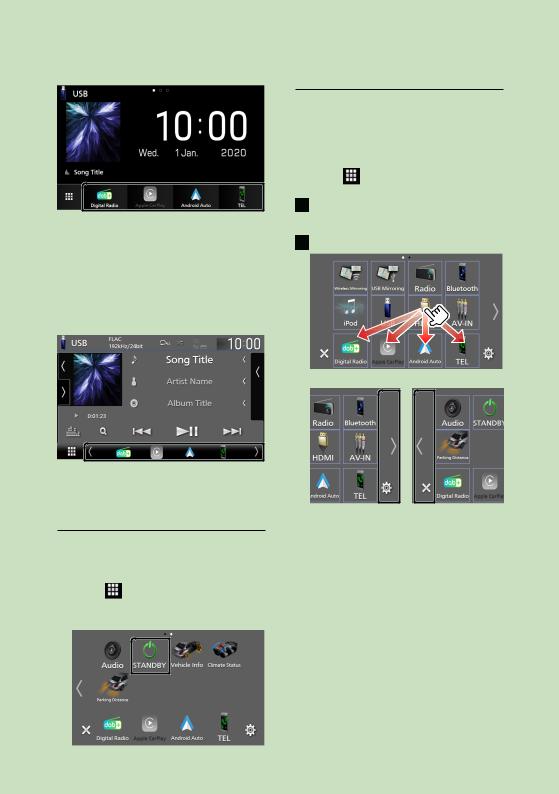
Basic Operations
To select the playback source on the HOME screen
The 4 items displayed on the source selection screen with large icons are shown on the HOME screen.
You can change the items displayed on this area by customizing the source selection screen. (P.14)
To select the playback source on the source control screen
Customize Short-cut source icons on HOME screen
You can arrange the positions of the source icons as you like.
|
|
1 |
Press the [HOME] button. |
|
hhHOME screen appears. |
|
|
2 |
Touch [ ]. |
3Touch and hold the icon which you want to move in the customizing mode.
4Drag the icon to the desired position.
Changes the page
Display source selection icons by touching [ ]/[
]/[ ] or flicking left or right on the source
] or flicking left or right on the source
control screen, then select a playback source.
Put the unit in standby
|
|
1 |
Press the [HOME] button. |
|
hhHOME screen appears. |
|
|
2 |
Touch [ ]. |
|
|
3 |
Touch [STANDBY]. |
14

Source control screen descriptions
There are some functions which can be performed from most screens.
Indicators
5 |
4 |
6 |
3 |
|
7 |
1 |
2 |
Short-cut source icons
1 
 All sources icon
All sources icon
Displays the source selection screen. (P.13)
2Secondary screen
•[ ]/[
]/[ ] : The Secondary screen changes to another one every time you touch it. You can also change the Secondary screen by flicking left or right on the screen.
] : The Secondary screen changes to another one every time you touch it. You can also change the Secondary screen by flicking left or right on the screen.
•Indicators: Displays the current source condition and so on.
––[ATT]: The attenuator is active.
––[DUAL]: The dual zone function is active.
––[MUTE]: The mute function is active.
––[LOUD]: The loudness control function is active.
•Short-cut source icons: The source changes to the one you have set with a short-cut. For the short-cut setting, refer to Customize Shortcut source icons on HOME screen (P.14).
3Content list
Displays the track/file/station/channel list.
4 

• Connected Bluetooth device information.
Basic Operations
5 Artwork & information
You can select whether to display an artwork and song information or only song information in more detail.
Touching the artwork area switches to the VU meter. (The USB, iPod, Bluetooth audio sources only)
Change the text size of song information when the "Small Audio Text" is set to "ON"/"OFF" in the User Interface screen (P.60).
6 Function panel
Touch the left side of the screen to display the function panel. Touch again to close the panel.
7 Operation keys
You can operate the current source with these operation keys. The available functions are different depending on the source type.
English 15
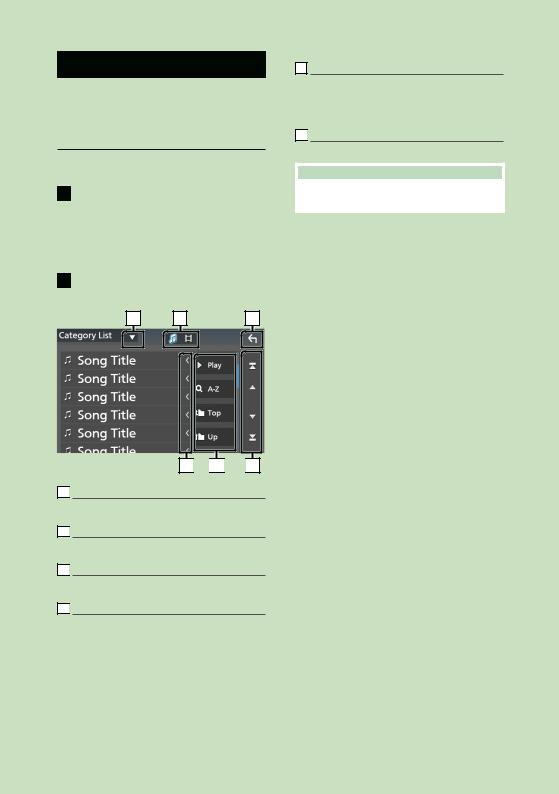
Basic Operations
List screen
There are some common function keys in the list screens of most sources.
See (P.31, 34, 48).
Display the list screen
For USB/iPod:
1Touch [1] or the item listed on the information area in the source control screen.
hThelist screen appears.
For Bluetooth audio:
1 Touch [1].
hThelist screen appears.
1 |
2 |
6 |
3 
 4
4 
 5
5
1 

Displays the list type selection window.
2 


Displays a music/movie file list.
3 
 Text scroll
Text scroll
Scrolls the displayed text.
4 
 etc.
etc.
Keys with various functions are displayed here.
• : Plays all tracks in the folder containing the current track.
: Plays all tracks in the folder containing the current track.
• : Jumps to the letter you entered (alphabetical search).
: Jumps to the letter you entered (alphabetical search).
•
 : Moves to the upper hierarchy level.
: Moves to the upper hierarchy level.
5 [ ]/[
]/[ ]/[
]/[ ]/[
]/[ ] Page scroll
] Page scroll
You can change pages to display more items by touching [ ]/[
]/[ ].
].
• [ ]/[
]/[ ] : Displays the top or bottom page.
] : Displays the top or bottom page.
6 
 Return
Return
Returns to the previous screen.
NOTE
•Depending on the current source or mode, some function key may not appear.
16
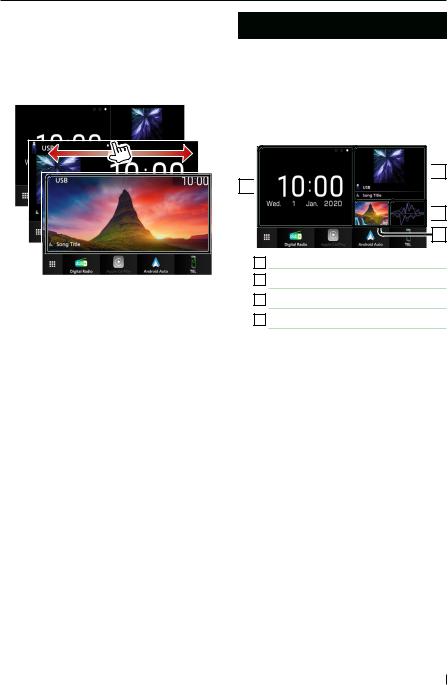
Widget
 Widget
Widget
Widget |
Multi Widget |
|
|
1 Press the [HOME] button.
2 You can change the widget by flicking left or right on the widget area.
Widget list
•Multi Widget *1
•Clock Widget
•Tire Pressure Widget *2
•Climate Widget *2
•Photo Frame Widget
*1 Up to 3 pages can be set to the multi widget screen. *2 This can be selected when a commercial adaptor is
connected.
You can place a widget on each of the following areas. Up to 4 widgets can be placed per a multi widget screen.
1 Press the [HOME] button.
2 Flick the widget area to the left/right to display the multi widget.
 2
2
1 
 4 3
4 3
1Widget (L)
2Widget (M)
3Widget (S1)
4Widget (S2)
ÑÑReplace the widget
●●To move the widget
1 Touch and hold the widget. hhWidget customize mode is activated.
2 Drag the widget to the desired position.
●●To delete the widget
1 Touch and hold the widget. hhWidget customize mode is activated.
2 Touch [×] on the right top corner of the widget.
hTheselected widget is deleted.
English 17

Widget
●●To replace the widget
1 Touch [ ] on the multi widget screen.
] on the multi widget screen.
1
hhWidget list popup appears.
1 Widget icon
The widgets which can be placed to the multi widget screen are listed.
2 Flick the widget list popup to the left/ right to select the widget to replace.
3 Touch and hold the new widget. hhWidget customize mode is activated.
4 Drag the widget from the widget list popup to the desired widget area.
You can set up following items.
•Clock Widget
•Current source information *1
•Visualizer Widget
•Mirroring Widget *2 *3
•Photo Frame Widget
•Climate Widget *4
•Tire Pressure Widget *4
*1 You cannot display the screen of Wireless Mirroring (DMX8020DABS only)/USB Mirroring on this widget. To display the screen of the source, select the Mirroring Widget.
*2 This can be selected when using Wireless Mirroring (DMX8020DABS only)/USB Mirroring.
*3 You cannot play the video file on the USB when using Wireless Mirroring (DMX8020DABS only)/USB Mirroring.
*4 This can be selected when a commercial adaptor is connected.
NOTE
•[ ] and the widget list popup disappear when no operation is done for 5 seconds.
] and the widget list popup disappear when no operation is done for 5 seconds.
•When the screen is switched from another widget to multi widget screen, [ ] appears again.
] appears again.
ÑÑAdd a new multi widget
You can add pages to the multi widget screen.
1 Touch [ ] on the multi widget screen. hhWidget list popup appears.
] on the multi widget screen. hhWidget list popup appears.
■■[ ]
]
Displays confirmation message to delete the current page from the multi widget screen. For details, see To delete the multi widget (P.18).
■ [ ]
]
Adds a page to the multi widget screen.
2 Touch [ ] on the widget list popup. hhA new page is added.
] on the widget list popup. hhA new page is added.
NOTE
•You can add up to pages to the 2 multi widget
screen. If you have already added 2 pages, you cannot select [ ].
].
•The widget tray is displayed on the new page until you place a widget to.
To delete the multi widget
1 Touch [ ] on the widget list popup. hhConfirmation message appears.
] on the widget list popup. hhConfirmation message appears.
2 Touch [YES].
hhCurrent page is deleted.
NOTE
•You cannot delete the first page of the multi widget screen.
18
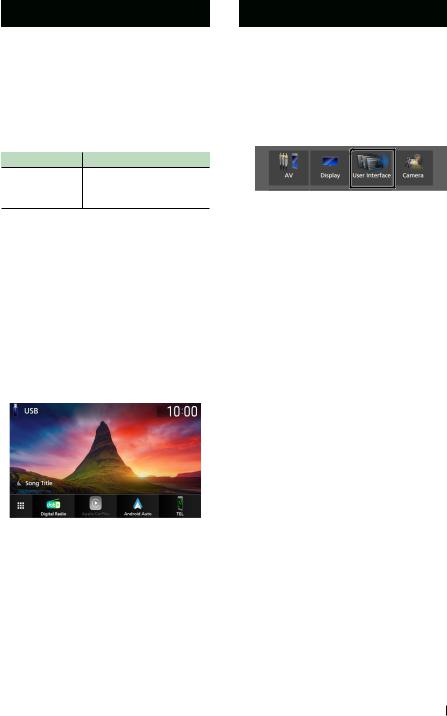
Photo Frame Widget
You can display a slideshow of the image files stored in the USB memory on the Home screen.
ÑÑPreparation
•Select “ON” for Photo Frame Widget. See
Widget SETUP (P.19).
●●Acceptable Picture files
Max. Picture size
JPEG (.jpg, .jpeg) *1 |
5,000 × 5,000 |
PNG (.png) |
1,000 × 1,000 |
BMP (.bmp) |
1,000 × 1,000 |
•This unit can only play back files which are less than 50 MB.
•The maximum number of files per device is 500.
•Picture files may not be played depending on their condition.
*1 A progressive format is not supported.
ÑÑPhoto Frame
1 Press the [HOME] button.
2 Flick the widget area to the left/right to display the photo frame widget.
• Scroll the screen to display the hidden part.
Widget
Widget SETUP
Set up the widgets on the Home screen.
1 Press the [MENU] button. hhPopup menu appears.
2 Touch [SETUP]. hhSETUP screen appears.
3 Touch [User Interface].
hhUser Interface screen appears.
4 Touch [Widget SETUP] in the User
Interface screen.
5 Set each item as follows.
■■[Photo Frame Widget]
Determine whether to use the photo frame widget.
"ON" (Default)/"OFF"
■■[Photo Frame SETUP]
Make settings related to display of the photo frame widget.
6 Touch [  ].
].
English 19
Widget
To Photo Frame Setup
Make settings related to display of the photo frame widget.
1 Touch [Photo Frame SETUP] on the
Widget SETUP screen.
2 Set each item as follows.
■■[Sort Order]
Specify a file sorting criterion.
"By Name(Ascending)"/
"By Name(Descending)"/
"By Date(Newest First)" (Default)/ "By Date(Oldest First)"
■■[Slide Show Interval]
Specify the slideshow interval. "5" to "30" seconds.
Default is "5" seconds.
■■[Photo Frame is • • • • •]
Display help topics about the photo frame.
3 Touch [  ].
].
20

APPS
 APPS
APPS
Wireless Mirroring Operation (DMX8020DABS)
You can display the same screen of the Android smartphone on the monitor of the unit using the Wireless Mirroring function of the Android smartphone.
Preparation
•You can use the Wireless Mirroring function with Android smartphones compatible with this function.
•This function may be called Wireless Display, Screen Mirroring, AllShare Cast, etc., depending on the manufacturer.
•The settings on the Android smartphone differ depending on the device type. For details, refer to the instruction manual supplied with your Android smartphone.
•If your Android smartphone is locked, Mirroring screen may not appear.
•If the Android smartphone is not ready for UIBC, you cannot perform touch operation..
USB Mirroring Operation
With Mirroring for KENWOOD application installed on your smartphone, you can display the screen of your smartphone on the screen of this unit and listen to either the audio of your smartphone or current source of this unit. You may access your smartphone from this unit.
You can use the USB Mirroring function with your smartphone compatible with this function.
Compatible devices
•Android smartphone
–Bluetooth support
–Android version 5.0 or later
–Linux Kernel version 3.5 or later
•iPhone
–Bluetooth support
–iOS version 11 or later
Preparation
1 |
Press the [HOME] button. |
2 |
Touch [ ]. |
3 |
Touch [Wireless Mirroring]. (P.13) |
|
hTheApp screen is displayed. |
4 |
Operate your Android smartphone to |
|
activate the Wireless Mirroring function, |
|
then connect to this unit. |
5 |
Select (”DMX8020DABS”) as the network |
|
to use. |
hWhenthe connection is established, then the same screen displayed on the Android smartphone is displayed.
NOTE
•Apps is discontinued when the power is turned ON/OFF or you leave the vehicle. To restart Apps, operate the Android smartphone..
•When the Apps source is displayed, you cannot register or reconnect a Bluetooth device. Switch the Apps source to another source, and then operate the Bluetooth device.
•Install the latest version of the Mirroring for KENWOOD application and activate the
application on your smartphone.
Android smartphone: Search for “Mirroring for KENWOOD” in Google Play to find and install the
most recent version.
iPhone: Search for “Mirroring for KENWOOD” in Apple App Store to find and install the most recent version.
Mirroring for KENWOOD application is a free application. You can check “how to” tutorial in Mirroring for KENWOOD application.
ÑÑConnect the device
Screen is mirrored through USB (Black) terminal connection while audio is shared via Bluetooth connection between this unit and your smartphone.
English 21

APPS
For Android smartphones:
1 |
Pair your Android smartphone with |
|
this unit via Bluetooth. See Register the |
|
Bluetooth device (P.44). |
|
Select A2DP/SPP [Audio/App]. |
2 |
Press the [HOME] button. |
3 |
Touch [ ]. |
4 |
Touch [USB Mirroring]. (P.13) |
5 |
Connect your Android smartphone via |
|
the USB (Black) terminal. (P.85) |
When you use Mirroring for KENWOOD application for the first time, the terms of service are displayed. It is necessary to agree to the terms of service to use this function.
For iPhone:
1 |
Pair your iPhone with this unit via |
|
Bluetooth. See Register the Bluetooth |
|
device (P.44). |
|
Select A2DP/SPP [Audio/App]. |
2 |
Touch “Mirroring for KENWOOD” and start |
|
broadcast. |
3 |
Press the [HOME] button. |
4 |
Touch [ ]. |
5 |
Touch [USB Mirroring]. (P.13) |
6 |
Connect your iPhone using KCA-iP103 via |
|
the USB (Black) terminal. (P.84) |
7 Operate your iPhone to complete followings.
•Launch “Settings”, then touch “Control Center” and then “Customize Controls”.
•Touch “Screen Recording” and add to “INCLUDE” list.
•Launch “Control Center” of your iPhone, then touch and hold Screen Recording icon.
NOTE
•USB (Gray) terminal does not support USB Mirroring. (DMX8020DABS only)
•You cannot use the Bluetooth and iPod sources at the same time with Mirroring for KENWOOD application.
•OSD clock is not shown on the mirroring screen of this unit regardless of the setting made for
[OSD Clock] (P.61).
•Depending on the connected Android smartphone, you may need to enable virtual keyboard setting on your smartphone to display software keyboard on the screen of this unit and on your smartphone.
•Mirroring for KENWOOD application is discontinued by the following operations if you use the application with an iPhone:
––Receiving an incoming call
––iPhone's screen recording function is stopped
––iPhone screen is turned off
To resume the mirroring operation, disconnect the iPhone from the USB Audio cable, and try connecting it again.
•The audio may be of poor quality, interrupted or skipped, depending on several conditions such as network condition, the application and etc.
•If you perform pairing with another device during mirroring, mirroring (audio and/or video) will be disturbed or paused.
•Some applications may not support audio sharing.
•Some operations may not work depending on the compatibility between this unit, Mirroring for KENWOOD application and your smartphone.
22

ÑÑOperation keys on the mirroring screen
On the USB mirroring screen, the following virtual hard keys are available. The keys are hidden when no operation is done for about 5 seconds. You can display back them anytime by touching the screen.
•[ 
 ]/[
]/[
 ]: Changes the virtual hard keys position shown on the screen of this unit.
]: Changes the virtual hard keys position shown on the screen of this unit.
•[○]: Returns to home page.
•[×]: Closes the virtual hard keys.
•[ ]: Shows the recent applications (Android only).
]: Shows the recent applications (Android only).
•[  ]: Returns to the previous page (Android only).
]: Returns to the previous page (Android only).
NOTE
•These keys differ depending on the connected device and may differ from the function operated from the device.
•These keys can be displayed even if there is no hard key on the connected device.
ÑÑDisconnect mirroring
You can disconnect mirroring by disconnecting your smartphone from the USB (Black) terminal from the rear panel.
NOTE
•Once you disconnect from mirroring operations, stop broadcast on iPhone's screen recording function. Otherwise “iPod” source and “Bluetooth” source may not work correctly.
APPS
Apple CarPlay Operation
Apple CarPlay is a smarter, safer way to use your iPhone in the car. Apple CarPlay takes the things you want to do with iPhone while driving and displays them on the screen of the product. You can get directions, make calls, send and receive messages, and listen to the music from iPhone while driving. You can also use Siri voice control to make it easier to operate iPhone.
For details about Apple CarPlay, visit https:// www.apple.com/ios/carplay/.
Compatible iPhone devices
You can use Apple CarPlay with the following iPhone models.
• iPhone XS Max |
• iPhone 7 Plus |
• iPhone XS |
• iPhone 7 |
• iPhone XR |
• iPhone SE |
• iPhone X |
• iPhone 6s Plus |
• iPhone 8 Plus |
• iPhone 6s |
• iPhone 8 |
|
ÑÑConnecting an iPhone
Preparation
•To register an iPhone by the connection via the USB (Black) terminal
––Connect an iPhone via the USB (Black) terminal and operate the iPhone according to the confirmation messages displayed on the iPhone. The iPhone is registered in [Apple CarPlay Device List]. Removing the iPhone from the USB (Black) terminal and selecting the registered iPhone from [Apple CarPlay Device List], the iPhone will be connected wirelessly.
•To register an iPhone by the connection via Bluetooth
––Touching [ ] on the [Apple CarPlay Device List] screen (P.24), displays Bluetooth
pairing waiting dialog. Referring to Register the Bluetooth device (P.44) and registering the iPhone, the iPhone will be connected wirelessly.
English 23

APPS
Wired connection
1 Connect your iPhone using KCA-iP103 via the USB (Black) terminal. (P.84)
When an iPhone compatible with Apple CarPlay is connected to the USB (Black) terminal, the Bluetooth Hands-Free phone currently connected is disconnected. If the Bluetooth Hands-Free phone is being used, disconnection will occur after ending the call.
2 Unlock your iPhone.
Wireless connection (DMX8020DABS)
You can select the iPhone registered as the Bluetooth device from [Apple CarPlay Device List] and use it as the Apple CarPlay device.
1 |
Press the [HOME] button. |
2 |
Touch [ ]. |
3 |
Touch [Apple CarPlay]. (P.13) |
NOTE
•Turn on the Bluetooth function and Wi-Fi function of an iPhone.
•If two or more iPhones have been registered, select the iPhone to be used as the [Apple CarPlay] source. (P.24)
•You can also select the iPhone registered in
[Apple CarPlay Device List] (P.24) even when the [Apple CarPlay] icon is not activated on the source selection screen.
•It is necessary to connect the GPS antenna and the speed pulse input in order to use a wireless Apple CarPlay.
•When the Wi-Fi connection becomes unavailable, the HOME screen is displayed.
•You cannot use Apple CarPlay if the iPhone's screen recording function is enabled.
To switch the Current Screen to the Apple CarPlay Screen When Connecting Your iPhone
•Touch [Apple CarPlay] icon on the source selection screen. (P.13)
•Touch the following connection message if the message appears.
NOTE
•The connection message appears when;
––The iPhone you used previously is connected again.
––The screen other than HOME and the source selection screen is displayed.
•The connection message is displayed for about 5 seconds.
ÑÑSelect an Apple CarPlay device
(DMX8020DABS)
If two or more iPhones compatible with Apple CarPlay have been registered, select the iPhone to be used as the Apple CarPlay source.
1 Press the [MENU] button. hhPopup menu appears.
2 Touch [SETUP]. hhSETUP screen appears.
3 Touch [AV].
4 Touch [Apple CarPlay Device List].
5 Select a device.
The Apple CarPlay device connected via the USB and the registered Apple CarPlay devices ready for wireless connection are displayed.
•[ ] : Displays a Bluetooth pairing waiting dialog. For details, see Register the Bluetooth device (P.44).
] : Displays a Bluetooth pairing waiting dialog. For details, see Register the Bluetooth device (P.44).
•[ ] : Displays confirmation message to disconnect the device.
] : Displays confirmation message to disconnect the device.
•[ ] : Displays Device Remove screen.
] : Displays Device Remove screen.
(P.25)
24

To delete the registered Apple CarPlay device
1 Touch [ ].
].
2 Touch the device name to check.
■■[þ[ALL]
Selects all Apple CarPlay devices.
■■[¨[ALL]
Clears all check marks.
3 Touch [Delete].
hhConfirmation message appears.
4 Touch [Yes].
hhAll the selected device(s) is deleted.
NOTE
•This operation also deletes the same device(s) from the Bluetooth device list screen. (P.46)
APPS
ÑÑOperation keys and available
Apps on the home screen of Apple CarPlay
You can use the Apps of the connected iPhone.
The items displayed and the language used on the screen differ among the connected devices.
To enter the Apple CarPlay mode, touch [Apple CarPlay] icon on the source selection screen. (P.13)
2
1 |
3 |
|
1[ ]*
]*
•Displays the home screen of Apple CarPlay.
•Touch and hold to activate Siri.
2Application keys
Starts the application.
3 [HOME]
Exits the Apple CarPlay screen and displays the Home screen.
*The icon design may change depending on the iOS version.
To exit the Apple CarPlay screen
1 Press the [HOME] button.
ÑÑUse Siri
You can activate Siri.
1 Press the [ ] button for 1 second.
Press for 1 second
2 Talk to Siri.
To deactivate
1 Press the [ ] button.
English 25
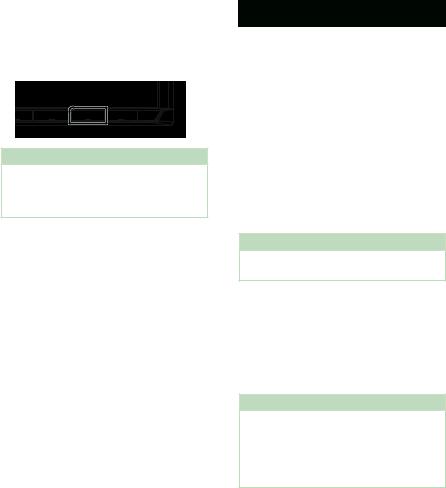
APPS
ÑÑSwitch to the Apple CarPlay screen while listening to another source
1 Press the [ ] button.
] button.
NOTE
•When listening to another source with the Apple CarPlay screen displayed, playing music in the Apple CarPlay mode will switch the current source to the Apple CarPlay source.
Android Auto™ Operation
Android Auto enables you to use the functions of your Android smartphone convenient
for driving. You can easily access route guidance, make calls, listen to music, and access convenient functions on the Android smartphone while driving.
For details about Android Auto, visit https:// www.android.com/auto/ and https://support. google.com/androidauto.
Compatible Android smartphones
You can use Android Auto with Android smartphones of Android version 5.0 or later.
For Wi-Fi connection, Android 8.0 or later. (DMX8020DABS)
NOTE
•Android Auto may not be available on all devices and may not be available in all countries or regions.
●●About the placement of smartphone
Install the smartphone connected as Android Auto device in the place where it can receive the GPS signals.
When using the Google Assistant, install the smartphone in the place where the smartphone easily catch a voice by the microphone.
NOTE
•Do not put the smartphone in a spot exposed to direct sunlight or near an air blowing out port of an air conditioner. The placement of the smartphone in such places can lead to malfunction or damage of your smartphone.
•Do not leave the smartphone in the vehicle.
26
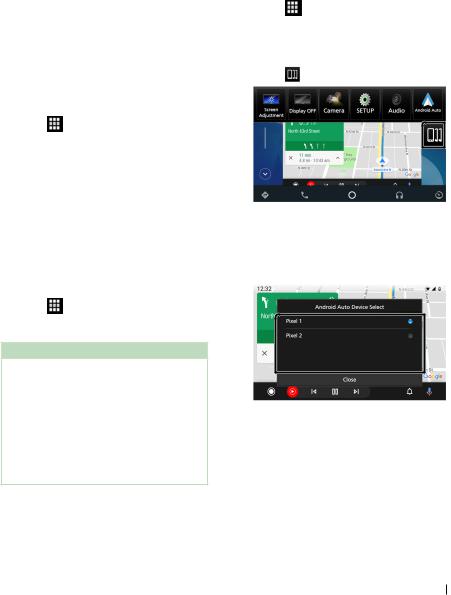
ÑÑConnect Android smartphone
Wired connection
1 |
Connect an Android smartphone via the |
|
USB terminal. (P.85) |
|
To use the hands-free function, connect the |
|
Android smartphone via Bluetooth. |
|
When an Android smartphone compatible |
|
with Android Auto is connected to the |
|
USB terminal, the device is connected via |
|
Bluetooth automatically, and the Bluetooth |
|
Hands-Free phone currently connected is |
|
disconnected. |
2 |
Unlock your Android smartphone. |
3 |
Press the [HOME] button. |
4 |
Touch [ ]. |
5 |
Touch [Android Auto]. (P.13) |
Wireless connection (DMX8020DABS)
When the Android smartphone is ready for wireless connection, connecting it via the USB registers Bluetooth and Wi-Fi automatically. Thus, the registered Android smartphone will be able to be connected wirelessly to be used as an Android Auto source.
1 |
Press the [HOME] button. |
2 |
Touch [ ]. |
3 |
Touch [Android Auto]. (P.13) |
NOTE
•Turn on the Bluetooth function and Wi-Fi function of Android smartphone.
•If two or more Android smartphone have been registered, select the Android smartphone to be used as the Android Auto source. (P.27)
•To change the password for wireless connection manually, refer to [Reset Android Auto Wireless Connection] (P.64).
•When the Wi-Fi connection becomes unavailable, the HOME screen is displayed.
APPS
ÑÑSelect an Android smartphone
(DMX8020DABS)
If two or more Android smartphones have been registered, select the Android
smartphones to be used as the Android Auto source.
1 |
Press the [HOME] button. |
|
2 |
Touch [ |
]. |
3 |
Touch [Android Auto]. (P.13) |
|
4 |
Press the [MENU] button. |
|
5 |
Touch [ |
]. |
6 Select an Android smartphone.
The registered Android smartphones ready for wireless connection and the Android smartphones connected via the USB are displayed.
English 27

APPS
ÑÑOperation keys and available
Apps on the Android Auto screen
You can perform the operations of the Apps of the connected Android smartphone.
The items displayed on the screen differ among the connected Android smartphone.
To enter the Android Auto mode, touch the [Android Auto] icon on the source selection screen. (P.13)
1 
1 Application/information keys
Starts the application or displays information.
To exit the Android Auto screen
1 Press the [HOME] button.
ÑÑUsing voice control
1 Press the [ |
] button for 1 second. |
Press for 1 second |
|
To cancel |
|
1 Press the [ |
] button. |
ÑÑSwitch to the Android Auto screen while listening to another source
1 Press the [ ] button.
NOTE
•When listening to another source with the Android Auto screen displayed, playing music in the Android Auto mode will switch the current source to the Android Auto source.
28

USB
 USB
USB
Connecting a USB device |
|
USB Basic Operation |
|
|
|
1 Connect the USB device with the USB cable. (P.84)
2 Press the [HOME] button.
3 Touch [ ].
4 Touch [USB]. (P.13)
ÑÑDisconnect the USB device
1 Press the [HOME] button.
2 Touch a source other than [USB].
3 Detach the USB device.
ÑÑUsable USB device
You can use a mass-storage-class USB device with this unit.
The word “USB device” appearing in this manual indicates a flash memory device.
●●About the file system
The file system should be the one of the following.
• FAT16 |
• FAT32 |
• exFAT |
• NTFS |
NOTE
•Install the USB device in the place where it will not affect safe driving.
•You cannot connect a USB device via a USB hub and Multi Card Reader.
•Take backups of the audio files used with this unit. The files can be erased depending on the operating conditions of the USB device.
We shall have no compensation for any damage arising from any erased data.
Most functions can be controlled from the source control screen and playback screen.
NOTE
•Set the remote controller mode switch to AUD mode before starting operation, see Switch the operation mode (P.74).
|
|
Control screen |
||
|
|
|
|
|
1 |
|
|
|
|
|
|
|
|
2 |
|
|
|
|
|
6 |
|
|
|
5 |
|
|
|
|
|
|
|
|
|
|
7 |
|
|
|
|
|
|
|
|
|
3
4
Open the drawer
7 |
|
|
|
|
5 |
|
|
||||
|
|
|
Close the drawer |
||
|
|
|
|
|
|
6 |
|
|
|
|
5 |
|
|
|
|
||
|
|
|
|
|
|
7 

 8
8
1[CODEC]/[ ]/[
]/[ ]
]
•When a high-resolution source is played, its format information is displayed.
•[ ] : Repeats the current track/folder. Each time you touch the key, repeat modes are switched in the following sequence:
] : Repeats the current track/folder. Each time you touch the key, repeat modes are switched in the following sequence:
File repeat (  ), Folder repeat (
), Folder repeat (  ), Repeat all (
), Repeat all (  )
)
English 29

USB
•[ ] : Randomly plays all tracks in the current folder. Each time you touch the key, random modes are switched in the following sequence: File random (
] : Randomly plays all tracks in the current folder. Each time you touch the key, random modes are switched in the following sequence: File random (  ), Random off (
), Random off (  )
)
2Track information
•Displays the information on the current file. Only a file name and a folder name are displayed if there is no tag information.
•Change the text size of the information when the "Small Audio Text" is set to "ON"/"OFF" in the User Interface screen (P.60).
3Play mode indicator/Playing time
•D, B, etc.: Current play mode indicator
Meanings of individual icons are as follows: D(play), B(fast forward), A(fast backward), H(pause).
•For confirmation of current playing position. You can drag the circle left or right to change the playing position. (Video file only)
4Operation keys
•1] : Searches track/file. For details on search operation, see Search Operation (P.31).
•E] [F] : Searches the previous/next track/ file.
Touch and hold to fast forward or fast backward. (It will be cancelled automatically after about 50 seconds.)
•[DH] : Plays or pauses.
•[ ] : Displays the Graphic Equalizer screen.
] : Displays the Graphic Equalizer screen.
(P.68)
5Content list
•Touch the right side of the screen to display the Content list. Touch again to close the list.
•Displays the playing list. When you touch a track/file name on the list, playback will start.
6Artwork/VU meter
•Displays/hides artwork area.
•The jacket of the currently playing file is displayed.
•Touch to switch between the artwork and VU meter.
7 Function panel
Touch the left side of the screen to display the function panel. Touch again to close the panel.
• [ |
] [ |
] : Searches for the previous/next |
folder. |
|
|
•[USB DEVICE CHANGE] :
Switches to another USB device when two USB devices are connected.
(DMX8020DABS only)
8Indicator Items
•[VIDEO]: Identifies the video file.
•[MUSIC]: Identifies the music file.
Video screen
9 |
9 |
10
9 File search area (Video file only)
Touch to search for the next/previous file.
10 Key display area (Video file only)
Touch to display the control screen.
30
